
Interviews
Interview with Kim Baumann Larsen of PLACEBO EFFECTS

Interview with Kim Baumann Larsen of PLACEBO EFFECTS
Kim Baumann Larsen, a Norwegian architect, is the CEO and partner of PLACEBO EFFECTS. His works are well published and have been featured in various public exhibits and on broadcast television. His services have been called upon for some of Norway's largest architectural projects, including the Oslo Gardermoen Airport and the new Telenor Fornebu headquarters.
CGA: Could you introduce yourself?
KBL: I am a 34 year old Norwegian and a licensed architect. Over the course of the last six years I've started up two architectural CG companies and I am currently CEO and partner of PLACEBO EFFECTS (www.placebo-fx.com). As part of my consulting I've been involved with OCEAN NORTH and headed the Information Technology department at the Oslo School of Architecture. My CGI work includes some of the largest architecture projects in Norway like the Oslo Gardermoen Airport and the new Telenor Fornebu headquarters.
CGA: Tell us about your background. How did you get into the Architectural CG industry?
KBL: I was brought up in a 'design home' with my mother a fashion designer and my dad an architect and they both worked out of our house. Drawing spaceships and building the designs in LEGO are fond memories from early years. Before entering the Oslo School of Architecture (AHO) I studied computer science at the University of Oslo. Then my interest for computing got fused with that of design and I pretty much ran the computer lab - all Macintoshes - the last couple of years of my studies. I spent a semester as a visiting student at ABACUS, at the University of Strathclyde in Glasgow, Scotland, preparing for my diploma. They had written their own radiosity software which ran on SGIs and I had a hard time getting it to work. I found 3D Studio on their PCs and naturally was hooked. My interest for design of
extreme environments led me to a Fulbright supported Masters of Architecture at the Sasakawa International Center for Space Architecture, University of Houston, USA.
We worked a lot with CAD and 3D and did a research project producing CG animation for the WGBH Apollo 13 documentary. As part of my Masters thesis "Virtual space - Conceptions of Reality" I worked for the Houston company Cybersim, where we developed PC-based VR solutions with Compaq for the architecture and entertainment industry.
When I returned home to Norway in 1995 it dawned on me that I liked rendering images of architecture perhaps more than designing architecture. I started my own company, Dimension Design (www.dimension.no), which I successfully ran for three years until PLACEBO EFFECTS was conceived. In fact Dimension is still alive although in a sleep mode.
CGA: Can you tell us about PLACEBO EFFECTS, and your role there?
KBL: Together with two architect friends and DARK Architects (www.dark.no) I started the visual effects company PLACEBO EFFECTS in early 1999. We have taken onboard a few more people since then and are now six. Most all of us have architecture background although we've also hired people with technical drafting experience and natural talents of 3D visualization.
With such a small company we have traded roles and I am currently the CEO. I try to keep the command structure fairly loose having taken on a coordination and marketing role. My love is really for making beautiful images though so I hope to soon be able to return to being more visually creative. It's quite a challenge to keep abreast with all the technological advances and manage a company at the same time. Our youngest employee will outrun anyone of us elders when it comes to modeling non-Cartesian geometry!
CGA: What is the primary focus of PLACEBO EFFECTS?
KBL: PLACEBO EFFECTS is partly owned by DARK - the largest architecture and design company in Norway. Our primary objective is to provide visualization services to the design and architecture community in Norway and to become a leader in this field. Since the start we have focused on high quality renderings using mostly Lightscape. With most architecture visualization companies in Norway being one and two man shops, or people solely doing in-house work in other architecture firms, I feel that we've come a long way towards reaching our goal.
 |
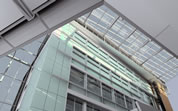 |
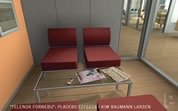 |
||
| Schibsted - Kim Baumann Larsen Click to enlarge |
Telenor1 - Kim Baumann Larsen Click to enlarge |
Telenor2 - Kim Baumann Larsen Click to enlarge |
CGA: What are your main sources of inspiration?
KBL: The arts, nature and my family. Literature, movies, music and visual arts give me a lot. Also I am fortunate to live in the middle of a city and still be able to get out into the forests, mountains and lakes close by to relax and reflect on my work. Sometimes though I find it hard to truly appreciate my surroundings always asking myself questions on how I would best go about simulating the various physical effects of reality in a CG environment!
CGA: Which artists, architects, designers inspire you the most?
KBL: Futurist Syd Mead (www.sydmead.com) has been a huge inspiration for me since early on. That is both in terms of his extraordinary drawing talents and his marvelous futuristic design concepts. His production designs for movies like Tron, Bladerunner and Aliens are stunning. Likewise the works of Ralph McQuarrie, production designer for the first STAR WARS trilogy. The works of my dad of course; in particular watching him work on conceptual designs like solving the intricate spatial relationships of a national airport on a piece of scrap paper; you couldn't do that with any computer tools that I know of. I am also a great fan of Japanese architecture and anime. The architect Shin Takamatsu produces architecture inspired by tools and machinery, and it plays on the traditional eastern notion of space being formed by the void and not by the solid as in the west. The work of Mamoru Oshii who directed "Ghost in the Shell", where Blade Runner type scenes of a futuristic Hong Kong like city evokes strong emotions. The storytelling techniques of anime
- how the background and the architecture is given much more detail than the
characters is very fascinating.
CGA: Can you talk a little bit about your work with OCEAN and OCEAN's
foundation?
KBL: Its difficult to give a short story version. You could say that the OCEAN network was conceived in the Graduate program at the Architecture Association School of Architecture (AA) in London, where professor Jeffrey Kipnis was very influential around the mid nineties. After graduating from AA some of the ex-students decided to do more than just keeping in touch.
OCEAN NORTH (www.ocean-north.net), an organization that was established as a
consolidation of the most active collaborations in the OCEAN network, is today an international group of architects, urban designers, industrial designers, and product designers that pursue design and experimental research in the form of design projects, education and cultural events. OCEAN NORTH is based in Helsinki with branch offices in Oslo and London. Of particular concern are time-based processes of formation and performance, coupling analytical and generative processes in design.
Much of the strength of OCEAN NORTH lies in its ability to draw on the resources of individuals in the network. My particular interest in working with OCEAN NORTH has been the experimentation with 3D and animation tools with respect to time-based design processes.
For me it all started at Electra'96 - an exhibit of electronic art and design at the Henie Onstad Art Center in Norway where I met with the exhibiting American architect Greg Lynn (www.glform.com), and the Norwegian architect Johan Bettum, one of the founders of the OCEAN network. I started working with Bettum and the Oslo node of the OCEAN network about a year later and up until last year I have been doing collaborative work traveling to both London and Helsinki.
I still do a fair bit of consulting for OCEAN NORTH, mostly visualization, although it is increasingly difficult to find time to do what are in essence non-profit work when one is deeply involved with commercial projects in ones own company.
CGA: Of the numerous 'fluid architecture' projects that you have worked on,
both with OCEAN and PLACEBO EFFECTS, which one was the most challenging and interesting? Why?
KBL: The project which I am most fond of is an architecture installation called Chamberworks, which was set up in a small gallery space in Oslo in the spring of 1998. It was personally fulfilling since I was involved with all aspects of the project from generating the initial digital particle system, 3d construction drawings and bending steel tubes and fixing them into place, painting the installation, rigging lights and sensors and even designing T-shirts for the opening event! I believe we succeeded in creating a new kind of space where bundles of steel rods and tubes created inter-spaces with loose boundaries and little or no hierarchy.
Perhaps the most challenging project I have undertaken with OCEAN NORTH was a collaborative research project partly funded by the Norwegian department for cultural affairs. It was named Tidsrom (loosely translated: Time-Space) and involved several young Norwegian contemporary composers and designers/architects from OCEAN NORTH. We wanted to research how we could use digital tools, developed for composing music, to create space on one hand and on the other use 3d design tools to create music and come up with a project that fused the two; music and space. Not as music to a space or a space for music but something quite different. We managed to find some clues as to how to go about doing it but it is difficult to find the right answers when one is not really sure what the questions are!
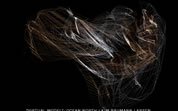 |
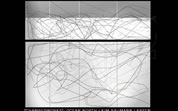 |
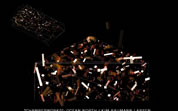 |
||
| Virmod - Kim Baumann Larsen Click to enlarge |
Chamberworks_3dmodel Kim Baumann Larsen Click to enlarge |
Chamberworks_Particles Kim Baumann Larsen Click to enlarge |
CGA: Your unique approach to using 3D design tools to design is very
interesting. Can you describe what techniques you have been using to
experiment with 'fluid architecture'? What prompted you to start
experimenting in this field?
KBL: Greg Lynn's work with 3D tools (Alias|Wavefront) and in particular blobs to create architecture was an eye opener for me. My work has been centered on using particle systems as generative engines for virtual models that eventually form the basis for architecture and design. Basically I set up a particle system with attractors and deflectors. By adding various effects to introduce noise and random factors you hope to get some sort of unpredictability out of the system. It is in the unknown and surprising events that we find the most promising "material" suited for further
development of the design. The sheer beauty and complexity of images and
animations that comes out of these processes continue to amaze me.
Lately I've been fueled with energy looking at really amazing fluid dynamic
simulations of solar activity. They are voxel based visualization of complex and computationally expensive calculations, so at the moment the tools lack the interactive touch and feel that is important if one is to use the software as a design tool.
CGA: Have any prominent building projects been designed using 'fluid
architecture'?
KBL: If you mean OCEAN NORTH designs then not really. We have built several
semi-permanent structures such as installations, exhibition designs and so on. But there are a number of other architects that design with similar techniques who have been able to get their works built, Greg Lynn for one. His Presbyterian church in New York was recently finished and he is currently working on several other projects which might get built. The Embryonic House project looks promising.
CGA: Your works are very well published, which project are you most proud of
and why?
KBL: That would be the computer animation of the Apollo 13 mission for the NOVA
television documentary "Apollo 13: To The Edge and Back" done in 1994. This
was a research project undertaken by the University of Houston, College of
Architecture for WGBH in Boston. A fellow graduate student John Cook (he now works for Boeing on the International Space Station), our CAD teacher and myself spent almost seven months researching and visualizing that NASA mission. It was a challenge to accurately portray all the different events and movements of the
spacecraft. We used a couple of PCs and the original 3D Studio package to
produce more than 10 minutes of TV quality animation. We felt we were helping to shed some light on what was in essence a marvelous event of ingenuity and NASA engineering, and we learned a tremendous amount about space flight, spacecraft design and computer animation. Of course the year after "our" film was premiered around the world on television, the movie "Apollo 13" with Tom Hanks, with visual effects by Digital Domain, blew us away with spectacular and much more realistic CG.
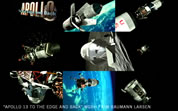 |
||||
| WGBH_Apollo13 Kim Baumann Larsen Click to enlarge |
CGA: What software do you currently use and have you used in the past for
your projects and why have you chosen those particular applications?
KBL: I started doing CG with Microstation back in 1990 as a result of winning an
Intergraph scholarship. Microstation is a very generic CAD program but extremely flexible and powerful for architecture modeling in my opinion, so I've stuck to it since for 3D modeling. The problem of rendering with that program was always that of lighting, especially when you had a huge model and dozens of lights. When I discovered Lightscape around 1996 I was sold. That program really gives you the lighting for free if you know how to model for radiosity meshes.
Lightscape does have its problems though, mainly that it is extremely time
consuming to make the models when you have to manually slice surfaces to reduce meshing artifacts. There are no advanced rendering features such as depth of field, motion blur and material wise you cannot have bumpmaps or any advanced texture types for that matter.
We are using 3D Studio MAX as our core application in PLACEBO EFFECTS. A lot of our works are process oriented 3D models where the hyper-realistic quality of Lightscape isn't needed. We have built a large library of 3D furniture and props in MAX format and with the advances of the Global Illumination renderers I believe we will be able to deliver higher visual quality earlier in the design process.
When it comes to compositing and image editing we are mostly doing stills and Photoshop is hard to do without. It is one program which I doubt I will ever be pushing to the limits. Recently we've started producing animations and we've invested in Discreet's Combustion which works really well with MAX using RPF (Rich Pixel Format). With RPF you get loads of channels in one single file; z, motion, transparency, color, object ID and so on and so forth. This allows you to do a lot of fixing and tweaking in post. The big problem with this of course is that you need a lot of hard disk space. You easily have file sizes of 40Mb per frame for video or 400Mb per frame for film.
Many projects are still rendered in Lightscape. There still isn't any one program that beats Lightscape in terms of visual quality in my opinion, and the way you interact with models in that program is just so intuitive.
CGA: What are your thoughts about emerging rendering technologies? What
technologies do you see leading the way in the architectural field?
KBL: Architecture in its essence is about light and how light reflects off and passes through materials in different ways. Radiosity based rendering and more recently GI is crucial to portray the play of light in architectural CG. With new and more efficient algorithms and renderers able to work with changing lighting conditions making virtual "architecture movies" with believable lighting will be feasible for small shops like ours.
We have started looking at different GI renderers, namely Marcos Fajardos Arnold and Brazil from Splutterfish and we can't wait to try out Cebas FinalRender which should arrive any day now. For the past year we have been fortunate to be beta testers of Arnold (really Alpha software since it has yet to become feature complete).
I have long thought that voxel based modeling and rendering would be hitting the mass market. It is big in medical visualization and scientific simulation of complex physical phenomenon like fluid dynamics. The gaming industry will probably take it on as soon as large amounts of ram are standard on PCs, like several gigabytes. Voxel based models will allow for more interactive environments in terms of one being able to cut and dig into objects which will have a mass and not a void inside of a polygon shell. Perhaps with the advent of sub-surface scattering, as demonstrated by Henrik Wann Jensen, and the notion that even solid "architectural" materials in reality have light
bouncing around inside will voxels come of age?
CGA: What do you feel are the current limitations of current rendering
technology?
KBL: Its inability to offer the loose and more open ended visuals of the hand sketch, rough cardboard and clay models. There are some plugins and filters that you can apply to renderings and models but they just don't cut it. A lot of our work consists of providing decision support in the early phases of a project and the renderings tend to look "finished" and fixed which is often quite the opposite of what you want. In addition there is the challenge of dealing with human perception in CGI.
On another note I have not been too impressed so far by the various GI renderers when it comes to architecture interiors. Both the Monte Carlo and photon based algorithms are prone to produce noisy images unless you have a lot of time on your hands which we usually don't have.
CGA: What have been your biggest challenges both past and present, with
regards to computer renderings?
KBL: There is always this ghost of cost effectiveness lurking in the background. Pride in making the models and images look their best, means you spend too much time on the project. Some of my best work, and most fun too, have been projects where I've found a ridiculously simple way of doing the job, resulting in spectacular images that really didn't take that much of an effort. It is very hard to be able to repeat those feats over and over again, but I guess it is about trying to keep things simple. Our work and life is complicated as it is!
Managing digital color space is also very hard. It is a big problem when image preview and materials in your 3D program looks way different than in your image editing suite not to mention your not so favorite presentation software. Then you have the RGB to CMYK conversion.
CGA: What is in the future for PLACEBO EFFECTS?
KBL: We are all very much fond of 3d with respect to computer games and movies and it would be great if we could expand into related areas such as virtual set design for the advertising, film and entertainment industry.
Personally I would like to work more with the moving image and film in particular. So far we've done CG for one music video - "We Are the Playmomen". It was part of a "Spinal Tap" kind of documentary film about the Norwegian boy-band Boyzvoice. We created and animated virtual sets for the music video. The idea was to put the three band members dressed in Playmomen suits inside of a little boys room at the scale of Playmomen figures (www.boyzboice.com).
There are a couple of successful game developers in Norway, Funcom who have done such games as "The Longest Journey" and recently "Anarchy Online" and Innerloop, and I think that we could offer valuable consulting to such companies both in terms of architecture and design for games (the virtual space, not the game architecture) as well as our knowledge of rendering of and movement through architectural spaces.
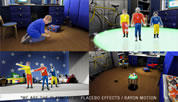 |
||||
| Playmomen_Collage Kim Baumann Larsen Click to enlarge |
CGA: What do you not like to see in computer generated architectural work?
KBL: People! I mean it is really difficult to avoid putting people in the renderings as they do provide scale and a warm atmosphere. Many clients will request it of course, but the pictures of people we put into the renderings often look misplaced. Unless you produce your own people library your images will look similar to the competition, and putting photo realistic people into not so-real renderings just doesn't look very good. Most professional architecture photographers will take pictures of architecture without people. I guess it is because I am an architect that I prefer architecture
without people!
CGA: What tip(s) can you give our readers to improve their architectural
renderings?
KBL: I think the single most important thing to do is to learn how to see. By that I mean that those of us who are not visually impaired really take our vision for granted. In order to understand how our vision works, free hand drawing is probably the most effective way to improve your skills with respect to doing visual effects. The essence of what you see comes down on the paper. I try to keep a small notepad and pencil with me at all times. The human form is fascinating and really hard to capture, but you could basically draw anything that comes into view, what is right in front of you in everyday situations.
Photography would also be a good thing to practice. As a CG architect you are basically a photographer working in your own virtual studio. I keep forgetting that what we are doing is not really simulating the real world (even when using physically based lighting), but more of setting and dressing a stage for a particular play. Everything is allowed; extra lights, props, impossible (in the real world) points of view as long as the image portrays the space in a way you and your client are happy with.
CGA: What is your favorite link to visit on the web? (not necessarily CG
related)
KBL: www.google.com - with so much junk on the net and more junk pages growing by the thousands each day Google judges a web page by how many other web pages link to that page and presumes that people do not want to link to bad web
pages.
CGA: Which/What web based resources have you found the most informative?
KBL: There really hasn't been many sites around specifically targeted towards CG
and architecture; up until now that is! For visual effects www.vfxpro.com is
a very valuable source and it is always a friendly reminder to me of where I
am going.
About this article
Kim Baumann Larsen, a Norwegian architect, is the CEO and partner of PLACEBO EFFECTS. His works are well published and have been featured in various public exhibits and on broadcast television...




